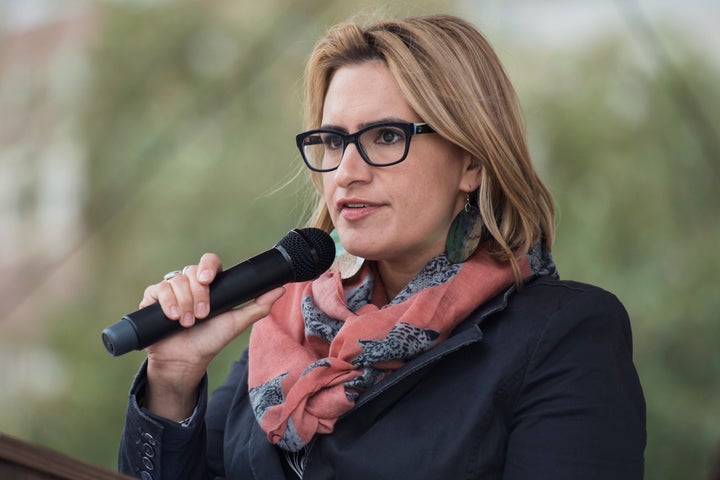Minnesota Lt. Gov. Peggy Flanagan was elected chair of the Democratic Lieutenant Governors Association on Tuesday, making history as the first Native American woman to lead a national political party committee.
Flanagan, who is the nation’s highest-ranking Native woman in elected office, said people shouldn’t ignore the role that Democratic lieutenant governors can play in enacting policies or winning elections. Generally their job is to support the governor and be there to fill in if the governor resigns or dies. But part of the job is what you make of it, she said, and the power of today’s crop of Democratic lieutenant governors derives from how many come from the social justice movement and have deep connections to these communities. Now they are in positions to deliver on the issues they’ve been organizing around for years.
“That is the secret sauce. That is what makes lieutenant governors so powerful,” Flanagan said in an interview. “We’ll make a difference in 2024.”
She noted that of the nation’s 25 current Democratic lieutenant governors, 12 are people of color and 14 are women.
“We are the most diverse group of statewide elected officials in the country,” she said. “This is the next generation of party leaders.”
Flanagan, who has been lieutenant governor since 2019, said her ties to progressive constituencies in her state were key to helping Democrats there build power, win elections and push through a generation’s worth of liberal reforms this year with a one-seat majority, elevating Minnesota to the forefront of progressive policymaking. The state’s new laws include 12 weeks of paid family and medical leave, free public college tuition for low- and middle-income families, driver’s licenses for all residents regardless of immigration status, and new protections for abortion rights and transgender youth.
“This past year, we’ve really showed the country that we can and must dream big,” said the Minnesota Democrat. “I think that is one of the reasons why my colleagues have elected me into this position. To show what is possible.”

The main purpose of the Democratic Lieutenant Governors Association is to help elect Democratic lieutenant governors and candidates in general. But it also serves as a bench for people going on to higher-profile posts. Sens. John Fetterman (D-Pa.) and Tina Smith (D-Minn.) were both lieutenant governors before becoming senators, for example. Gov. Gavin Newsom (D-Calif.) was previously the lieutenant governor.
Smith, for one, was incredibly active and effective as lieutenant governor before she came to the Senate. Flanagan is certainly influenced by her predecessor.
Looking ahead to the 2024 elections, Flanagan said she’s constantly thinking of ways to boost Indigenous voters’ turnout at the polls. She’s been working on this for two decades and said it’s remarkable how much has changed in recent years.
“We can flip elections,” she said of Native voters, reflecting on the 2020 elections. “We did, right? We showed up, registered, flipped seats and turned out.”
Indigenous voters were crucial to President Joe Biden’s victory. They turned out in droves for him in key swing states like Wisconsin and Arizona, far surpassing turnout levels in previous elections and arguably making the difference for him in these states.
There’s been an uptick in Native people running for local office, too, said Flanagan, for posts such as county commissioner, school board member or state legislator. She attributes this movement to Native people, for the first time, seeing themselves represented at the highest levels of government, whether it’s Rep. Sharice Davids (D-Kan.) in Congress or Interior Secretary Deb Haaland in the Cabinet.
“Visibility like that is incredibly important,” said the Minnesota Democrat. “We see ourselves reflected in leadership in a way we never have before.”
In her new role as chair, Flanagan said a major priority is to flip North Carolina’s lieutenant governor seat from Republican to Democratic. That seat is currently held by Republican Mark Robinson, a bonkers conspiracy theorist who is running for governor.
She also wants to bring the perspective of someone who just helped her state usher in huge progressive policy change. Those wins didn’t just happen because Democrats control all of state government there, she said. It was the culmination of decades of organizing for this moment, having policies ready to go and moving as quickly as possible to pass them into law when Democrats came into power.
This is where Democratic lieutenant governors can step up their roles in their states to do the same, Flanagan said, and thrive as leaders in their own right.
The Democratic Lieutenant Governors Association has become “a place where people are looking toward leaders who will be the next governor, the next U.S. senator, the next congressperson,” she said. “This is a place where we’ve got highly qualified, effect leaders who understand how to govern.”
“We are changing the narrative and the role of lieutenant governors.”

